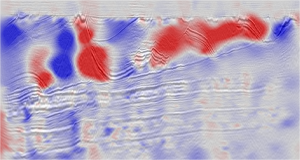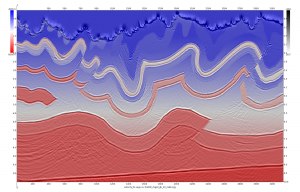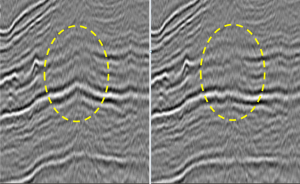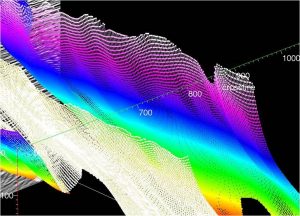Our Technology IP Portfolio contains flexible, 100% proprietary software that serves as the engine for all of our Services. The benefit? Our clients frequently present us with “what if” concepts, then we quickly reconfigure our existing technology in order to solve their unique challenges—usually within 24-48 hours of their request. Compare our business model to our competitors’ business model of “leased” software. By nature, leased software cannot be quickly modified and, therefore, cannot keep pace with today’s rapidly shifting and complex E&P environment.
Velocity: The Essential Thing
In the search for hydrocarbons, geophysicists use seismic data primarily to better define subsurface structures and stratigraphy, as well as interpreting the amplitudes, phase, and frequencies to characterize rocks and pore fluids. In all cases, seismic velocity remains the essential detail. An accurate velocity, including anisotropy, is the key to...
In-Depth Time Processing
Since 2014, we have extended our capabilities to capture the entire seismic processing spectrum—from preprocessing techniques to refraction and reflection statics to multi-dimensional noise attenuation to migration and post-migration image enhancement. We have developed the proprietary workflow SmartMerge, and routinely run RTM+ migrations during time processing for QC, making sure...
Depth Imaging vs. Diffraction Imaging
Generic depth imaging improves reflected energies, while seismic diffraction imaging reduces them. In fact, the goal of diffraction imaging is to scale down the reflected energies, within limits. Why do this? Because by reducing the reflected energies, as best as possible, the diffraction results reveal subtle features that are below...
2D Processing with 3D Model Building
2.5D Tomography Our approach to 2D tomography is centered about accurate imaging and horizon consistency across line ties. Starting with an initial 3D velocity model, each iteration of tomography updates the 3D model. The result is a true 2.5D approach with geological consistency across all 2D lines. Our 2.5D tomography...
In-Depth Reservoir Services
In-Depth Geophysical Reservoir Services helps clients identify, de-risk, and develop reservoirs by identifying key reservoir rock properties, like lithology and fluids. We apply integrated geophysical, geological, petrophysical, and rock physics methods in order to characterize reservoirs.
FWI+
In-Depth’s Full Waveform Inversion
FWI+: In-Depth's Full Waveform Inversion In-Depth’s FWI+ uses the actual acquisition geometry to estimate the misfit function. The algorithm uses refracted energies in the shallow section and naturally transits to reflected energies in the deeper area. It typically use 3~4 frequency bands between 3 Hz and 15 Hz. It is...
3D Tomography with Beam Offset or RTM Angle Gathers

At In-Depth, we believe the key to successful imaging is not just imaging alone, but also meticulous velocity model building. We have developed and maintained some of the industry’s most sophisticated proprietary velocity packages, including our k-semblance, fault-constraints, dip/structure-guided constraints, and depth-velocity decoupled system. Our Fault Constrained Tomo handles full-azimuth/multi-azimuth, Gaussian...
Full Gaussian Beam & Fast Beam

Our fast Gaussian Beam is perfect for building velocity models quickly and thoroughly. Where Kirchhoff fails to properly image high dip angle sediment and salt flanks, Gaussian Beam naturally handles turning rays and multipathing with superb imaging results. While Kirchhoff has been outstanding in seismic processing and remains the most versatile...
RTM+
In-Depth’s Reverse Time Migration

Reverse Time Migration has established itself as the most rigorous and accurate imaging tool for unraveling complicated geology—especially when involving the structure of evaporites (salt, carbonates, and anhydrites) . In-Depth’s RTM+ handles multi-pathing, two-way, wave based, >90 degree dips, and many other complex imaging scenarios. By contrast, Kirchhoff simply fails...
Scenario Testing

Scenario Testing is another proprietary Pre-Stack Depth Migration workflow developed by In-Depth. Uncertainties arise when imagers attempt to decide between multiple geological scenarios. With In-Depth’s Interactive Imaging workflow, we can help you eliminate some of the guesswork from the equation. Our Interactive Imaging allows you to draw several scenario models and quickly turn...
Fault-Constrained Depth Imaging

In-Depth’s proprietary technology–Fault Constrained PSDM Workflow–automatically scans the dip field and utilizes the fault’s planes in both imaging and velocity model building. Using the fault and horizon information to guide the imaging and velocity updating helps the workflow produce geological compliant images. We have routinely provided our clients with these...